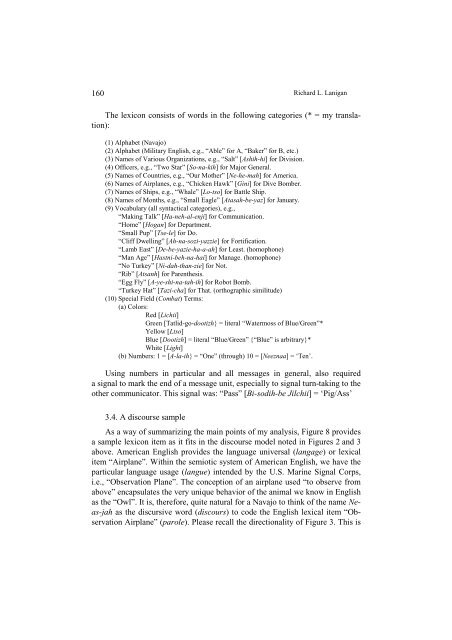s - Wyższa SzkoÅa Filologiczna we WrocÅawiu
s - Wyższa SzkoÅa Filologiczna we WrocÅawiu
s - Wyższa SzkoÅa Filologiczna we WrocÅawiu
You also want an ePaper? Increase the reach of your titles
YUMPU automatically turns print PDFs into web optimized ePapers that Google loves.
160<br />
Richard L. Lanigan<br />
The lexicon consists of words in the following categories (* = my translation):<br />
(1) Alphabet (Navajo)<br />
(2) Alphabet (Military English, e.g., “Able” for A, “Baker” for B, etc.)<br />
(3) Names of Various Organizations, e.g., “Salt” [Ashih-hi] for Division.<br />
(4) Officers, e.g., “Two Star” [So-na-kih] for Major General.<br />
(5) Names of Countries, e.g., “Our Mother” [Ne-he-mah] for America.<br />
(6) Names of Airplanes, e.g., “Chicken Hawk” [Gini] for Dive Bomber.<br />
(7) Names of Ships, e.g., “Whale” [Lo-tso] for Battle Ship.<br />
(8) Names of Months, e.g., “Small Eagle” [Atasah-be-yaz] for January.<br />
(9) Vocabulary (all syntactical categories), e.g.,<br />
“Making Talk” [Ha-neh-al-enji] for Communication.<br />
“Home” [Hogan] for Department.<br />
“Small Pup” [Tse-le] for Do.<br />
“Cliff D<strong>we</strong>lling” [Ah-na-sozi-yazzie] for Fortification.<br />
“Lamb East” [De-be-yazie-ha-a-ah] for Least. (homophone)<br />
“Man Age” [Hastni-beh-na-hai] for Manage. (homophone)<br />
“No Turkey” [Ni-dah-than-zie] for Not.<br />
“Rib” [Atsanh] for Parenthesis.<br />
“Egg Fly” [A-ye-shi-na-tah-ih] for Robot Bomb.<br />
“Turkey Hat” [Tazi-cha] for That. (orthographic similitude)<br />
(10) Special Field (Combat) Terms:<br />
(a) Colors:<br />
Red [Lichii]<br />
Green [Tatlid-go-dootizh} = literal “Watermoss of Blue/Green”*<br />
Yellow [Ltso]<br />
Blue [Dootizh] = literal “Blue/Green” {“Blue” is arbitrary}*<br />
White [Lighi]<br />
(b) Numbers: 1 = [A-la-ih} = “One” (through) 10 = [Neeznaa] = ‘Ten’.<br />
Using numbers in particular and all messages in general, also required<br />
a signal to mark the end of a message unit, especially to signal turn-taking to the<br />
other communicator. This signal was: “Pass” [Bi-sodih-be Jilchii] = ‘Pig/Ass’<br />
3.4. A discourse sample<br />
As a way of summarizing the main points of my analysis, Figure 8 provides<br />
a sample lexicon item as it fits in the discourse model noted in Figures 2 and 3<br />
above. American English provides the language universal (langage) or lexical<br />
item “Airplane”. Within the semiotic system of American English, <strong>we</strong> have the<br />
particular language usage (langue) intended by the U.S. Marine Signal Corps,<br />
i.e., “Observation Plane”. The conception of an airplane used “to observe from<br />
above” encapsulates the very unique behavior of the animal <strong>we</strong> know in English<br />
as the “Owl”. It is, therefore, quite natural for a Navajo to think of the name Neas-jah<br />
as the discursive word (discours) to code the English lexical item “Observation<br />
Airplane” (parole). Please recall the directionality of Figure 3. This is
















